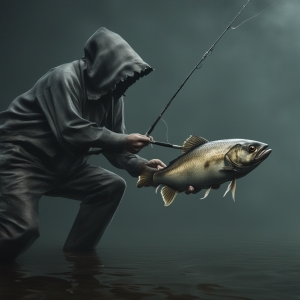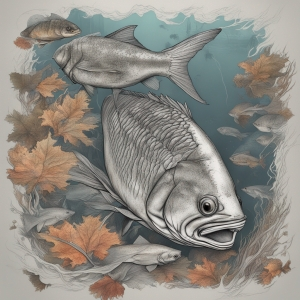Table of Contents:
The Stealth Approach: Silent Fishing Techniques for Spooky Fish
As an angler, you may have faced instances where your seemingly perfect lure or bait gets outright ignored by fish. Sometimes, the problem isn't in your tackle box, it's in your approach. Fish have a sharp sense of hearing and can get spooked easily by loud sounds or abrupt movements in and around their habitat. This is especially true for species like trout, carp, and bass, often referred to as "spooky fish". Learning how to be more stealthy and silent while fishing can increase your chances of a successful catch. In this article, we provide valuable insights on silent fishing techniques that can help you effectively catch these elusive, spooky fish.
Getting Started with Stealth Fishing
Stealth fishing isn't overly complex, but it does require some practice and patience. It primarily revolves around reducing noise, vibration and your visual presence near the fishing spot. Consider your approach as you would a hunting game, where any wrong step may scare away your prize. Let's go through the basics.
Pros and Cons of Silent Fishing Techniques for Spooky Fish
| Pros | Cons | |
|---|---|---|
| Stealth | Less likely to scare the fish away | Requires more patience and skill |
| Silent Casting | Does not disturb the water surface | Difficult in windy conditions |
| Slow Movement | Does not create noise or vibrations | Takes more time |
What is Stealth Fishing?

Stealth fishing is a highly targeted approach to angling, where an angler utilises techniques designed to minimise disturbances within the fishing environment. The primary goal is to avoid alerting fish to their presence. Simply put – the less aware the fish are of your presence, the higher the chance you’ll have of successfully landing a catch. This doesn't just involve moving quietly and mindfully, but also includes strategies about where to cast from, and even the colors of your clothing and gear.
How to Implement the Stealth Fishing Technique?
Implementing the stealth fishing technique involves careful consideration of several factors. Let's take a detailed look at them:
Maintain a Safe Distance

One of the first steps in stealth fishing is keeping a safe distance away from the fish. This reduces the likelihood of the fish detecting your presence. Devices like a fishing kayak or a float tube can be of great help. They allow you to get close enough to the fish without scaring them away.
Control Your Noise Level
Controlling your noise level means keeping the sounds you make, whether from talking or moving around your gear, to a minimum. Remember, any sharp, sudden noises can scare away fish. So you will want to tread lightly, speak softly, and handle your gear gently!
Be Mindful of Your Colors

The color of your clothing and gear can affect your fishing success too. Stick to neutral and earthy tones that blend with the natural environment, avoiding bright, flashy colors that could grab the fish’s attention.
Choose the Right Time
The right time to fish can also increase your chances of a successful catch. Early morning or late evening, when the world is naturally quieter, can be the perfect times for a stealthy approach. Being aware of the fish's feeding habits can also give you a clue as to when they are most likely to bite.
Essential Gear for Stealth Fishing
Having the right gear is crucial when adopting a stealth fishing approach. Let's delve into the basic essentials:
Fishing Rods and Lines
Choose a fishing rod and line appropriate for the type of fish you're targeting. Lighter rods and lines are generally more discreet and less likely to spook fish, but they should still be robust enough to handle a substantial catch.
Color-Coordinated Gear
Color is a vital factor. Select fishing gear that blends with the surroundings. Clear or green fishing lines, for instance, are less visible underwater. Your tackle box, camping gear, and even your hat should ideally be in earth-toned colors.
Low-Noise Gear
Emitting a loud noise can ruin your stealth approach. Choose lures, reels, and other fishing gear that operate quietly. Avoid metallic containers that clang and consider using padded cases to dampen noise from your gear.
Minimalist Approach
You don't need a multitude of tools clanking around. Being a stealthy angler often means adopting a minimalist approach. Bring only essential gear and keep your fishing station clean and organized. Not only does this reduce noise, but it also makes for a more efficient and enjoyable fishing experience.
Lure Selection for Spooky Fish
Another critical aspect of stealth fishing is your choice of lure. With spooky fish, natural presentation is key. They can be highly suspicious of anything out of the ordinary in their environment, so lures that mimic the look, movement, and even scent of their natural prey are typically the most effective. This might mean a soft plastic worm for bass, a lifelike fly for trout, or corn kernels for carp.
Color can also play a part – opt for realistic or subdued colors instead of brighter, flashier options. Be sure to consider the size of your lure as well. Bigger isn't always better when fishing for spooky fish. A smaller lure can often be less threatening and more enticing to a wary fish.
Finally, remember to be delicate in your casting. A lure that crashes into the water is likely to scare off any nearby fish. Soft, accurate casting techniques can help ensure your lure enters the water as naturally and quietly as possible.
Advantages of Stealth Fishing
Stealth fishing offers an array of benefits that can make your angling more successful and enjoyable. Firstly, it enhances your observation skills. By moving carefully and quietly, you become more attuned to your surroundings, noticing subtle movements and sounds that may indicate the presence of fish. This heightened awareness can significantly increase your chances of making a catch.
Secondly, stealth fishing can be thrilling. The quiet, measured approach can heighten the sense of anticipation and make the eventual catch all the more satisfying. It's almost like a game of hide-and-seek, where your careful maneuvering and patience pay off with a successful catch.
Finally, stealth fishing can also help protect the fishing environment. By reducing noise and disturbance, you can ensure the fish remain comfortable in their natural habitat, thereby promoting a balanced and healthy ecosystem. Not only does this augment the joy of fishing, but it also helps in conserving the aquatic fauna for future generations.
Key Points in Silent Fishing
Let's do a quick recap and highlight essential takeaways:
Understanding Fish Behavior
Knowing fish behavior and patterns can greatly increase your success. Each species has unique characteristics, feeding patterns, and preferred habitats - knowing these can help tailor your stealth approach.
Importance of Observation
Observation skills are crucial in silent fishing. Keep an eye on the water around you for signs of fish activity, like feeding or schooling. This valuable information helps determine the best locations and times to cast your line.
Going Unseen
Apart from the physical noise, your shadow or sudden movements can also alarm fish. Aim to move slowly, and try to avoid casting a shadow over the water where you plan to fish.
Speed and Amount of Casts
Don’t rush or overcast. Making too many casts in quick succession can disturb the water and alert fish to your presence. Instead, make fewer, more thought out casts. Some patience can lead to impressive results.
Practice Makes Perfect
Silent Fishing requires practice. Take the time to learn how to move quietly, cast effectively and handle your gear silently. Every fishing trip is an opportunity to improve these skills.
Respect for Nature
While we focus on silent fishing techniques, it's essential to remember that respect for nature and the environment is our topmost priority as anglers. We are visitors in the fish's home, and we should treat it as such.
Stealth Fishing: Maintaining Patience and Silence
Patient handling and making less noise are the two pillars of stealth fishing. Any sudden or loud motion can generate waves and disturb the silent underwater world. Therefore, you need to be calm, patient and slow in all your movements- whether it's adjusting the reel, casting the line or even celebrating a catch. Remember to stay silent and communicate softly if you're fishing with partners. Excessive sound travels through water and can spook fish easily.
Patience is equally crucial in stealth fishing. It might take longer to get a catch because fish needs time to relax in its environment. The temptation can be strong to frequently change your bait or spot, but try to resist. Stick with one fishing spot and keep your lure in the water as long as you can. Each removal and splashing recast can scare the fish and make them more alert. Remember the key motto in stealth fishing: Patience and Silence reign supreme.
Concluding the Stealth Approach to Spooky Fish
In conclusion, stealth fishing is an art that requires a keen understanding of fish behavior, a careful approach, and the right tools. It's all about blending into the environment and making your presence as unnoticeable as possible. From maintaining distance to being mindful of your noise and color, every detail adds up to create a stealthy profile. Remember to study your target fish’s behaviors and adjust your techniques to suit. With practice, patience, and persistence, you will increase your chances of catching that elusive spooky fish. Whether you're a beginner or an experienced angler, incorporating these silent fishing techniques into your routine can take your angling skills to new heights. Happy fishing!
FAQ on Silent Fishing Techniques for Elusive Fish
What is the stealth approach in fishing?
The stealth approach in fishing refers to various techniques designed to catch fish without spooking them. It often involves using silent equipment and minimizing noise and disturbances in the water.
Why is stealth important in fishing?
Stealth is important in fishing because noise and disturbances can easily scare fish away. Being silent and unnoticed can increase the chances of hooking a fish.
What are some techniques for silent fishing?
Some techniques for silent fishing include minimizing movement, using silent equipment, avoiding casting shadows over the water, and using baits that do not create a lot of splash.
How can I practice the stealth approach?
Practicing the stealth approach involves careful casting, moving slowly and quietly, using silent equipment, and understanding the behavior and senses of the fish you are trying to catch.
What is the biggest challenge in silent fishing?
The biggest challenge in silent fishing is remaining unnoticed by the fish. This requires patience, skill, and a good understanding of fish behavior and fishing environment.







